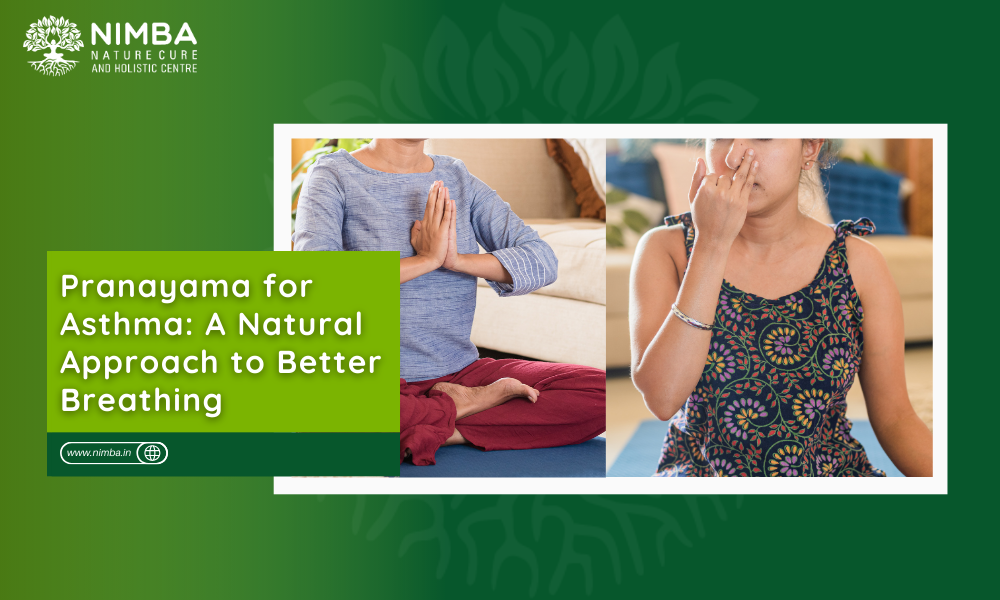Pranayama for Asthma: A Natural Approach to Better Breathing
By: Nimba - September 10, 2024
People in our society are always under pressure, worry, and anxiety, which makes it difficult to keep concentrated. One approach to improve mental health is mindfulness—that is, awareness of the present moment and a re-connection with oneself. The premier naturopathy treatment centre in Gujarat, Nimba Nature Cure, bases their whole approach on natural health techniques like Pranayama for asthma. This article looks at eight effective mindfulness exercises meant to harmonise your mind, body, and soul, thereby encouraging a balanced and better existence.
Alternative and complementary medicine in the management of asthma is incorporated into a multi-faceted programme at the Nimba Nature Cure – the Best Naturopathy Treatment Centre in Gujarat. Since it involves the act of controlled breathing, this form of practice also benefits the lungs, reduces inflammation and soothes the nerves, thereby enabling a better control of asthmatic symptoms.
How Pranayama Helps Asthma Patients
Pranayama helps in increasing the lungs capacity, tone of the respiratory muscles and thus reducing the stress response which is normally associated with asthma attack. If practised consistently then Pranayama can result in vast enhancements to one’s breath intake as well as respiratory system. Here’s how it helps:
- Improves Oxygen Flow: Pranayama improves the amount of oxygen in the lungs and the rate at which oxygen is exchanged thus relieving asthmatic patients.
- Reduces Stress and Anxiety: Employees also suffer from asthma which has the main cause being stress. Since pranayama involves slow breathing, it affects the parasympathetic nervous system which leads to reduction of stress.
- Strengthens Respiratory Muscles: Some of the Pranayama exert pressure on the diaphragm and/or intercostal muscles thereby enhancing lung capacity and efficiency.
- Enhances Lung Function: The institutions recommend that practice be conducted on a regular basis because doing so will definitely enhance lung capacity thereby enhancing the ability of the patient to respond to an asthma attack.
Key Pranayama Techniques for Asthma
There are several Pranayama techniques that are particularly beneficial for asthma patients. These simple yet powerful breathing exercises can be easily incorporated into daily routines and are designed to promote relaxation, improve lung function, and reduce asthma symptoms.
Anulom Vilom (Alternate Nostril Breathing)
-
-
- How it helps: Balances oxygen flow, clears nasal passages, and improves lung function.
- How to practise: Inhale through one nostril while closing the other, then switch nostrils for exhalation.
-
Bhastrika Pranayama (Bellows Breathing)
-
-
- How it helps: Increases lung capacity, improves oxygen intake, and strengthens respiratory muscles.
- How to practise: Take deep, forceful breaths in and out rapidly through the nose, using the diaphragm.
-
Ujjayi Pranayama (Ocean Breath)
-
-
- How it helps: Promotes relaxation and regulates airflow, helping to calm the airways during asthma attacks.
- How to practise: Inhale and exhale slowly through the nose while creating a constricted sound at the back of the throat.
-
Nadi Shodhana (Purification Breath)
-
- How it helps: Detoxifies the respiratory system, improves lung capacity, and balances energy in the body.
- How to practise: Inhale through one nostril and exhale through the other, alternating between nostrils.
These techniques are simple to learn and can be practised at home. However, for optimal results, it’s beneficial to learn these techniques under the guidance of an expert, such as those at Nimba Nature Cure.
Why Choose Nimba Nature Cure for Pranayama?
At Nimba Nature Cure, the focus is on offering a natural, holistic approach to health. As the best naturopathy treatment centre in Gujarat, Nimba combines Pranayama with other naturopathy treatments, yoga, and a well-balanced diet to help individuals manage asthma more effectively. With a serene environment and professional guidance, Nimba is the ideal place to learn and practise Pranayama for long-term respiratory health.





